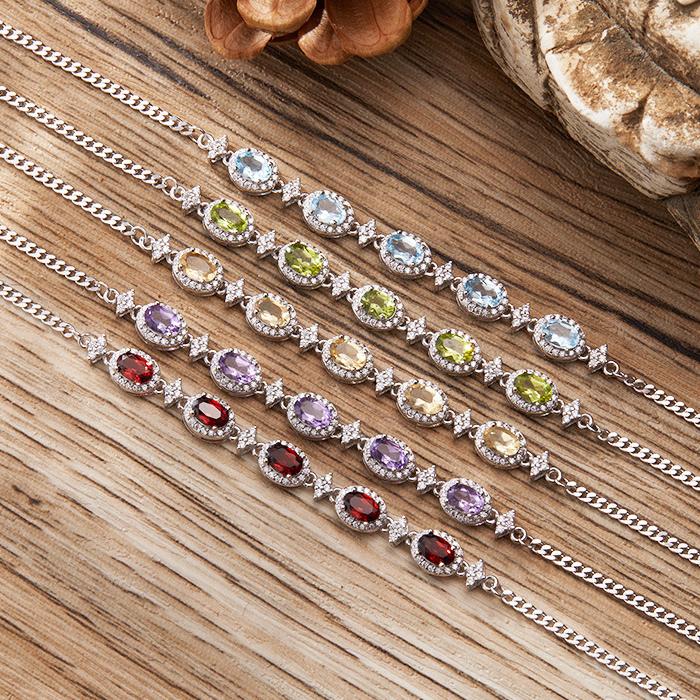
The Profound Meaning of Garnet, Citrine, Amethyst, and Other Gemstones in Jewelry
Share
In the dazzling realm of jewelry, gemstones transcend their aesthetic appeal to embody deep meanings, cultural traditions, and spiritual significance. From the passionate red of garnet to the tranquil purple of amethyst, each stone carries a unique narrative. This article explores the symbolic meanings of garnet, citrine, amethyst, clear quartz, topaz, peridot, and tanzanite, shedding light on how these precious gems enrich both our personal lives and jewelry collections.
Garnet: The Symbol of Enduring Love
Named after its resemblance to pomegranate seeds, garnet has long been associated with love, loyalty, and devotion. In ancient Egypt, it was believed to protect romantic bonds and ensure lasting commitment. During the Middle Ages, European knights carried garnet talismans into battle—not only for protection but also as cherished tokens from their beloveds. Scientifically, garnet contains minerals such as magnesium and iron, and is thought to enhance circulation and vitality. Whether featured as the center stone in an engagement ring or as a pendant on a delicate chain, garnet quietly expresses enduring affection.

Citrine: The Stone of Prosperity and Opportunity
With its radiant golden hue reminiscent of sunlight, citrine is widely regarded as a symbol of prosperity and good fortune. In many Eastern cultures, it is closely associated with financial success and is often displayed in workplaces to attract wealth. In Western mythology, citrine is linked to Apollo, the god of the sun, and is believed to dispel negative energies while promoting optimism. Contemporary psychological studies suggest that the color yellow stimulates mental activity, encouraging creativity and ambition. Citrine jewelry, such as necklace or earrings, not only enhances one’s appearance but also serves as a daily affirmation of abundance and potential.

Amethyst: The Crystal of Spirituality and Wisdom
The alluring purple hues of amethyst have fascinated human civilizations for centuries. In ancient Greece, it was believed that amethyst could prevent intoxication, leading to its use in the creation of drinking vessels. Within Christian traditions, amethyst is often featured in bishops' rings, symbolizing spiritual nobility and divine connection. From an energetic standpoint, amethyst is thought to enhance mental focus and intuitive insight, making it particularly beneficial for students and professionals in creative fields. Whether worn as a minimalist single-stone pendant or incorporated into a sophisticated multi-stone ring, amethyst jewelry radiates elegance and intellectual refinement.

Rock Crystal: The Symbol of Purity and Balance
Rock crystal or called clear quartz or white crystal. Frequently referred to as the "King of Crystals," rock crystal embodies purity, clarity, and balance. In various crystal healing practices, it is employed to purify the mind and body of negative energies, thereby promoting mental clarity during meditation. In traditional Eastern feng shui, rock crystal objects are strategically placed within living spaces to dispel negative influences and invite positive energy. With its versatile and understated aesthetic, rock crystal remains a favored element in jewelry design—whether combined with metalwork for a contemporary necklace or set into a watch face to convey subtle sophistication.

Topaz: The Messenger of Hope and Peace
Available across a wide spectrum of colors, topaz—particularly the blue variant—is widely regarded as a symbol of hope, peace, and friendship. In Western traditions, topaz is recognized as the birthstone for November, representing loyalty and affection. Due to its relatively high hardness on the Mohs scale, topaz is durable and well-suited for daily wear. Its brilliant luster enhances the aesthetic appeal of any jewelry piece. Whether featured in a pendant, earrings, or a ring, topaz exudes a sense of tranquility and timeless charm.

Peridot: The Gem of New Beginnings and Hope
Characterized by its vivid greenish-yellow hue, peridot evokes the vitality and freshness of spring, symbolizing renewal, hope, and happiness. In ancient Egypt, peridot was revered as the "Gem of the Sun," with beliefs that it emitted a glow in the dark and offered protection against negative energies. Contemporary studies suggest that the color green has a calming effect on both the eyes and the mind. Peridot jewelry, especially suited for summer wear, brings a touch of natural elegance to any outfit, reminiscent of wearing a fragment of flourishing nature.

Tanzanite: The Epitome of Mystery and Nobility
Exclusive to Tanzania, tanzanite is renowned for its deep and captivating blue-violet hue, reminiscent of the boundless cosmos, conveying an aura of mystery and nobility. Discovered in recent history, this gemstone swiftly rose to prominence within the jewelry industry, earning recognition as the "Fifth Precious Stone" following diamonds, rubies, sapphires, and emeralds. Its popularity reached new heights as it inspired the design of the iconic "Heart of the Ocean" necklace featured in the film Titanic.
Wearing tanzanite jewelry not only reflects refined taste but also establishes a symbolic connection between the wearer and the vast beauty of the universe.

These precious gemstones are more than mere decorative objects; they represent tangible manifestations of our hopes, dreams, and emotions. Whether one is attracted to a gemstone for its aesthetic value or its symbolic significance, the process of selecting the right piece of jewelry is an inherently personal experience. Allow these gemstones to accompany you on your journey, infusing your life with a sense of meaning and enchantment. We invite you to explore our collection and discover the ideal gemstone jewelry that reflects your unique story.